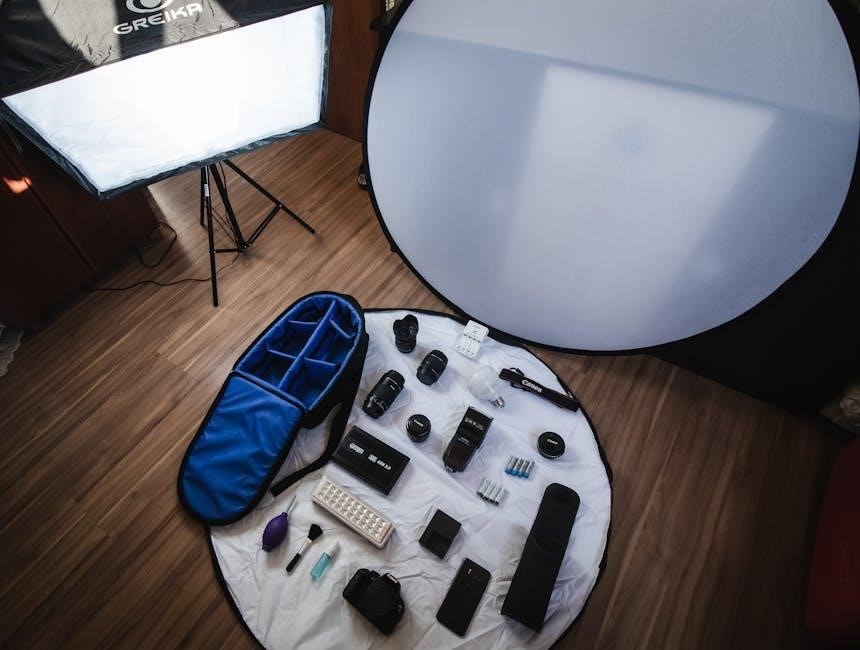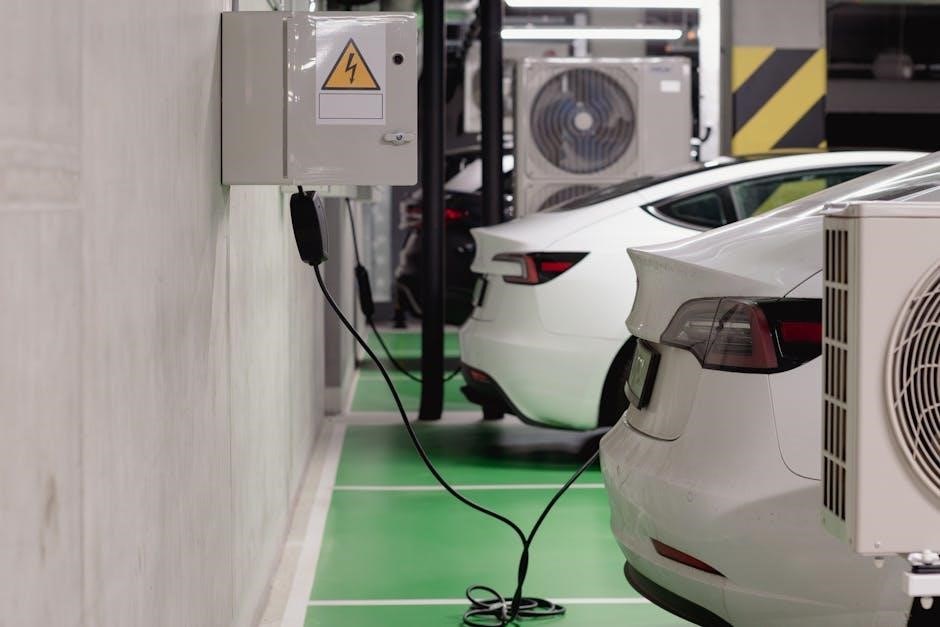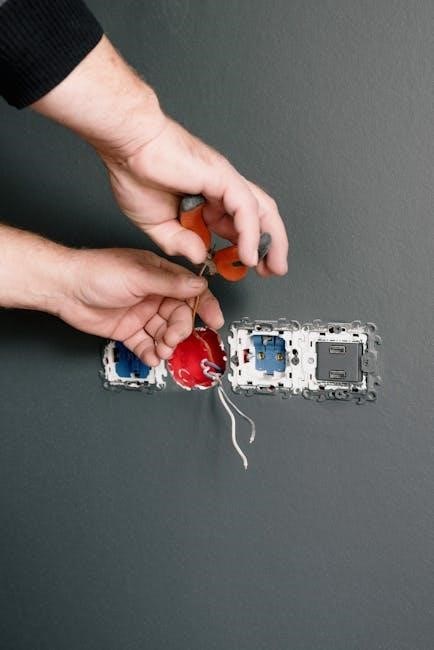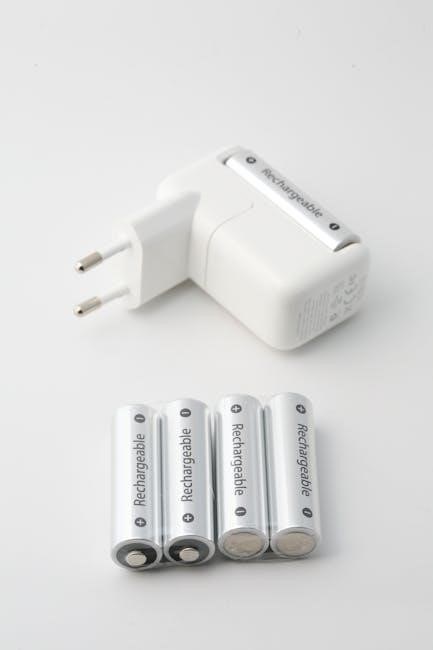
The DSR ProSeries Battery Charger is a professional-grade solution for charging and jump-starting 6V/12V batteries, designed for efficient performance and reliability in various automotive applications․
1․1 Overview of the DSR ProSeries Battery Charger
The DSR ProSeries Battery Charger is a versatile and powerful tool designed for both professional and amateur use․ It supports 6V/12V batteries and offers high peak amp ratings, making it ideal for jump-starting vehicles with ease․ The charger features a built-in 3-amp automatic charger, perfect for maintaining battery health and ensuring optimal performance․ Its professional-grade design includes a robust construction and user-friendly controls, allowing for precise monitoring of charging progress․ The device also serves as an engine starter, providing added convenience for users․ With a focus on safety and efficiency, the DSR ProSeries Battery Charger is an essential tool for automotive enthusiasts and professionals alike․ Its comprehensive functionality ensures reliable performance across various applications, making it a trusted choice for battery management needs․
1․2 Importance of the Manual for Safe and Effective Use
The manual is essential for ensuring the safe and effective use of the DSR ProSeries Battery Charger․ It provides critical safety guidelines, such as avoiding placement of the charger directly above the battery to prevent gas corrosion and ensuring proper ventilation to avoid hazardous fumes․ The manual also outlines precautions like preventing battery acid from dripping onto the charger and avoiding operation in closed-in areas․ By following the manual, users can prevent accidents, protect the charger from damage, and maintain optimal performance․ Reading and understanding the manual before each use is crucial for safe operation and maximizing the lifespan of both the charger and the battery․ It serves as a comprehensive guide to unlocking the full potential of the DSR ProSeries Battery Charger while minimizing risks․
Key Features and Specifications
The DSR ProSeries Battery Charger features a 6V/12V 225A capacity, high peak amps for jump starting, a built-in 3-amp automatic charger, and professional-grade design․
2․1 6V/12V 225A ProSeries Manual Battery Charger/Engine Starter
The DSR ProSeries 6V/12V 225A Manual Battery Charger/Engine Starter is a versatile and powerful tool designed for both charging and jump-starting applications․ It supports 6V and 12V batteries, making it suitable for a wide range of vehicles and equipment․ With a high current capacity of 225A, it delivers reliable performance for jump-starting and charging deep-cycle and standard batteries․ The manual operation allows users to have full control over the charging process, ensuring precision and safety․ This feature is particularly useful for professionals who need to handle various battery types․ The charger also doubles as an engine starter, providing an all-in-one solution for automotive maintenance․ Its robust design ensures durability and efficiency, making it a reliable choice for heavy-duty use․
2․2 High Peak Amp Rating for Jump Starting
The DSR ProSeries Battery Charger features a high peak amp rating, specifically designed to handle demanding jump-starting tasks․ This capability ensures rapid and reliable engine starting, even for vehicles with large engines or those in cold weather conditions․ The peak amp rating provides the necessary power surge to jump-start dead batteries efficiently, making it ideal for professional use․ This feature is particularly beneficial for heavy-duty vehicles, such as trucks or SUVs, where a strong, consistent power output is essential․ The charger’s high peak amp rating also enhances safety by reducing the risk of overloading or damaging the battery during the jump-starting process․ This makes it a trusted solution for emergency situations and routine maintenance alike․
2․3 Built-In 3-Amp Automatic Charger
The DSR ProSeries Battery Charger includes a built-in 3-amp automatic charger, designed for efficient and safe battery maintenance․ This feature automatically adjusts the charging rate to prevent overcharging, ensuring optimal battery health․ Ideal for both small and large batteries, the 3-amp charger is perfect for long-term maintenance, keeping batteries at their peak capacity․ Its automatic functionality eliminates the need for constant monitoring, making it a convenient solution for users․ The charger also incorporates safety features to prevent overheating and battery damage․ This makes it an excellent choice for professionals and enthusiasts alike, providing reliable performance and extending battery lifespan․ The built-in charger ensures that your batteries are always ready for use, whether for automotive applications or other devices requiring consistent power․
2․4 Professional-Grade Design and Functionality
The DSR ProSeries Battery Charger boasts a professional-grade design and functionality, making it a reliable tool for automotive professionals and enthusiasts․ Its durable construction ensures long-lasting performance, while its intuitive interface provides easy operation․ The charger is engineered with advanced safety features, such as overcharge protection and thermal monitoring, to safeguard both the user and the battery․ Designed for versatility, it supports both 6V and 12V batteries, catering to a wide range of vehicles and applications․ The professional-grade functionality includes precise charging control, automatic shut-off, and a robust cooling system to maintain optimal performance․ These features ensure the charger delivers consistent results, making it an indispensable asset for professionals who demand reliability and efficiency in their work․

Safety Precautions and Guidelines
Adhering to safety guidelines is crucial when using the DSR ProSeries Battery Charger to prevent accidents․ Ensure proper ventilation, avoid closed spaces, and keep the charger away from flammable materials․ Never place the charger directly above the battery to prevent corrosion from gases․ Avoid battery acid spills and ensure all connections are secure before charging․ Always follow the manual’s instructions for safe and effective use․
3․1 General Safety Guidelines
Always follow safety guidelines when using the DSR ProSeries Battery Charger to ensure safe and effective operation․ NEVER place the charger directly above the battery, as gases from the battery can corrode the charger․ Avoid operating the charger in closed or poorly ventilated areas, as this can lead to the accumulation of hazardous fumes․ Keep the charger away from flammable materials and ensure no battery acid drips onto the charger during use․ Properly secure all connections before charging to prevent sparks or electrical hazards․ Always read and follow the manual’s instructions carefully to minimize risks and ensure optimal performance․ Proper safety practices will help protect both the user and the equipment from potential damage or harm․
3․2 Handling Batteries Safely
When handling batteries with the DSR ProSeries Battery Charger, always wear protective gear such as gloves and goggles to prevent injury from acid spills or electrical arcs․ Ensure the battery is placed on a stable, flat surface away from flammable materials․ Never allow battery acid to drip onto the charger or other surfaces, as it can cause damage or corrosion․ Avoid over-tightening terminal clamps, as this may damage the battery posts․ Always disconnect the negative (ground) terminal first to prevent accidental short circuits․ Keep the area well-ventilated to avoid inhaling hazardous fumes․ Properly secure the battery in the vehicle or workstation before charging or jump-starting to ensure safe and stable operation․ Following these guidelines will help protect both the user and the equipment from potential hazards․
3․3 Operating Environment Precautions
To ensure safe and effective use of the DSR ProSeries Battery Charger, always operate it in a well-ventilated area to prevent the accumulation of explosive gases․ Never place the charger directly above the battery, as battery gases can corrode the charger․ Avoid operating the charger in a closed-in or poorly ventilated space, as this can lead to dangerous gas buildup․ Keep the charger away from open flames, sparks, or other ignition sources․ Do not expose the charger to extreme temperatures, direct sunlight, or moisture, as this may damage the unit or compromise its performance․ Ensure the surface where the charger is placed is stable and non-flammable․ By adhering to these precautions, you can minimize risks and ensure safe, efficient charging and jump-starting operations․
3․4 Emergency Procedures
In case of an emergency while using the DSR ProSeries Battery Charger, follow these steps to ensure safety․ If the battery begins to emit excessive gas, smoke, or overheats, immediately disconnect the charger and ventilate the area․ Never attempt to open the battery or charger housing․ If battery acid comes into contact with skin or eyes, flush with water for at least 15 minutes and seek medical attention․ In the event of a charger malfunction, turn off the power supply and unplug the unit․ Do not use water to extinguish electrical fires; instead, use a dry chemical fire extinguisher․ Keep a fire extinguisher nearby when operating the charger․ Always prioritize personal safety and avoid risky interventions during emergencies․

Installation and Setup
Begin by reading the manual thoroughly, then charge the internal battery for at least 8 hours before first use․ Prepare the charger according to the setup guide․
4․1 Preparing the Charger for Use
Before using the DSR ProSeries Battery Charger, carefully unpack and inspect the unit for any damage․ Ensure all accessories, such as cables and connectors, are included and in good condition․ Charge the internal battery for at least 8 hours before first use to ensure optimal performance․ Place the charger on a stable, non-conductive surface in a well-ventilated area, away from flammable materials․ Avoid positioning the charger directly above the battery to prevent corrosion from battery gases․ Read the manual thoroughly to understand the charger’s features and safety precautions․ Finally, perform a quick test to ensure all functions operate correctly before connecting it to a battery․
4․2 Initial Setup and Configuration
After unpacking, begin by charging the internal battery for at least 8 hours using the built-in 3-amp automatic charger․ Connect the charger to a power source using an 18-gauge or larger extension cord․ Once charged, press the display button to confirm the battery status, ensuring it reaches 100% charge․ Next, familiarize yourself with the charger’s controls and settings․ Select the appropriate charging mode for your battery type (6V or 12V) using the provided controls․ Ensure all cables and connectors are securely attached and free from damage․ Finally, test the charger by connecting it to a battery and monitoring the charge level to ensure proper functionality․ This initial setup ensures the charger is ready for safe and effective use․
4․3 Connecting the Battery
When connecting the battery, ensure the charger is placed on a stable, vented surface away from the battery to prevent gas corrosion․ Attach the heavy-duty cables to the charger’s terminals, ensuring the positive (red) clamp connects to the battery’s positive post and the negative (black) clamp to the negative post or a grounded metal surface․ Always connect the cables in the correct order to avoid sparks․ Double-check the charger’s controls to confirm the correct voltage (6V or 12V) is selected for your battery type․ Secure all connections firmly to prevent loose contacts․ Once connected, monitor the charger’s display for charging progress and ensure no flammable materials are nearby․ Never leave the charger unattended during operation to ensure safety and proper charging․

Charging Procedures
Follow the DSR ProSeries manual guidelines to select the correct charging mode, monitor the process safely, and ensure optimal battery performance by adhering to the charger’s instructions․
5․1 Selecting the Correct Charging Mode
Selecting the correct charging mode is crucial for safe and effective battery charging․ The DSR ProSeries Battery Charger offers multiple modes to suit different battery types and charging needs․ For standard charging, use the 12V mode, while the 6V mode is ideal for smaller batteries or maintenance charging․ Always refer to the manual to ensure compatibility with your specific battery type․ The charger features an easy-to-read meter, allowing you to monitor the charging progress accurately․ Additionally, the 135-minute timer provides precise control over the charging duration, preventing overcharging․ By selecting the appropriate mode and utilizing the built-in features, you can ensure optimal charging performance and extend the life of your battery․
5․2 Monitoring the Charging Process
Monitoring the charging process is essential to ensure safety and efficiency․ The DSR ProSeries Battery Charger features an easy-to-read meter that displays the charging progress, allowing you to track the voltage and current levels accurately․ Additionally, the 135-minute timer provides precise control, enabling you to set the charging duration according to your needs․ It is important to periodically check the connections and ensure they are secure to avoid any interruptions․ The charger also includes an automatic shut-off feature when the battery is fully charged, preventing overcharging․ Always monitor the battery’s charge level and adjust the settings as necessary to maintain optimal performance․ Proper monitoring ensures the battery is charged safely and effectively, extending its lifespan and reliability․
5․3 Post-Charging Procedures
After the charging process is complete, ensure the battery is disconnected from the charger to prevent any accidental power drain or electrical issues․ Check the battery terminals for tightness and cleanliness to maintain proper connections․ If the charger features an automatic shut-off, verify that it has activated correctly․ Store the battery in a cool, dry, and well-ventilated area, away from flammable materials․ For long-term storage, maintain the battery at a 50% charge level and recharge it every 3-6 months to prevent sulfation․ Regularly inspect the battery for signs of wear, such as corrosion or swelling, and address any issues promptly․ Proper post-charging care ensures the battery remains in optimal condition and extends its lifespan․

Troubleshooting Common Issues
Identify error codes, check connections, and ensure proper ventilation․ Consult the manual for solutions to issues like faulty charging or unexpected shutdowns during operation․
6․1 Diagnosing Common Problems
Diagnosing common issues with the DSR ProSeries Battery Charger involves checking error codes, connections, and operational conditions․ Common problems include faulty charging, unexpected shutdowns, or battery malfunctions․ Error codes like E1, E2, or E3 indicate specific issues such as overcharging, thermal overload, or communication errors․ Users should first ensure all cables are securely connected and free from damage․ Improper ventilation or extreme temperatures can also trigger errors․ If the charger fails to power on, check the mains supply and circuit breaker․ For battery-related issues, verify the battery type and condition․ Always refer to the manual for code interpretations and step-by-step troubleshooting guides․ Regular maintenance and inspections can help prevent these issues and ensure optimal performance․
6․2 Understanding Error Codes
Understanding error codes is essential for troubleshooting the DSR ProSeries Battery Charger․ Common codes like E1, E2, and E3 indicate specific issues such as overcharging, thermal overload, or communication errors․ When an error occurs, the charger displays the code on its screen, guiding you to the problem․ For example, E1 often signifies an overcharging condition, while E2 may point to a thermal issue․ Refer to the manual for a detailed list of codes and their meanings․ To resolve errors, ensure all connections are secure, check ventilation for proper airflow, and verify battery compatibility․ In some cases, resetting the charger or allowing it to cool down may resolve the issue․ Always consult the manual for code-specific solutions to ensure safe and effective troubleshooting․
6․3 Maintenance Tips for Optimal Performance
Regular maintenance ensures the DSR ProSeries Battery Charger operates at peak efficiency․ Clean the charger and battery terminals periodically to prevent corrosion and ensure proper conductivity․ Store the charger in a cool, dry place away from direct sunlight to maintain its internal components․ Check the cables and connectors for damage or wear; replace them if necessary to avoid connectivity issues․ Keep the internal battery charged, especially during extended storage, to prevent deep discharge․ Avoid exposing the charger to extreme temperatures, as this can affect its performance and longevity․ Follow the manual’s guidelines for proper care and storage to maximize the charger’s lifespan and reliability․ By adhering to these maintenance tips, you can ensure the charger remains a trusted tool for years to come․

Frequently Asked Questions (FAQs)
This section addresses common queries about the DSR ProSeries Battery Charger, including compatibility, charging times, and troubleshooting, helping users resolve issues quickly and efficiently․
7․1 Compatibility with Different Battery Types
The DSR ProSeries Battery Charger is designed to work with both 6V and 12V lead-acid batteries, including standard, AGM, and deep-cycle types․ It ensures compatibility with a wide range of automotive, marine, and heavy-duty applications․ The charger’s professional-grade design allows it to adapt to various battery chemistries while maintaining safe and efficient charging․ Always consult the manual to confirm compatibility with your specific battery type for optimal performance and safety․ This versatility makes it a reliable choice for users with diverse power needs․ Ensure your battery matches the charger’s specifications to avoid potential issues and extend its lifespan․ Refer to the manual for detailed guidelines on battery compatibility and charging procedures․
7․2 Charging Time and Battery Capacity
The DSR ProSeries Battery Charger efficiently charges 6V and 12V batteries, with charging time varying based on battery capacity and depth of discharge․ For example, deeply discharged batteries may require 8–12 hours for a full charge, while smaller batteries or those with lighter discharge may charge faster․ The built-in 3-amp automatic charger ensures safe and efficient charging, adapting to the battery’s needs․ It’s important to monitor the charging process, as the charger’s meter provides real-time updates on progress․ Always refer to the manual for specific guidelines on charging times for your battery type․ Proper charging ensures optimal performance and extends battery life․ Avoid overcharging, as the charger’s automatic feature helps prevent this by shutting off once the battery is fully charged․
7․3 Troubleshooting Common User Issues
Common issues with the DSR ProSeries Battery Charger often relate to improper connections or environmental factors․ If the charger fails to start, ensure all cables are securely connected and free from corrosion․ Verify the power source is functioning correctly․ For slow charging, check the battery’s capacity and depth of discharge․ If error codes appear, refer to the manual for specific solutions․ Overheating can occur in poorly ventilated areas; ensure the charger is in a well-ventilated space․ For internal battery charging issues, confirm the charger is fully plugged in and allow the recommended 8 hours for initial charging․ Always follow safety guidelines to prevent accidents․ If problems persist, consult the troubleshooting section in the manual or contact customer support for assistance․
The DSR ProSeries Battery Charger is a reliable, professional-grade tool for charging and jump-starting․ Follow the manual’s guidelines for optimal performance and safety․
8․1 Summary of Key Points
The DSR ProSeries Battery Charger is a professional-grade tool designed for safe and effective charging of 6V/12V batteries․ It features a high peak amp rating for jump-starting, a built-in 3-amp automatic charger, and a robust design for heavy-duty use․ The manual emphasizes critical safety precautions, such as proper ventilation, avoiding acid spills, and never placing the charger directly above the battery․ Users are advised to follow installation, charging, and troubleshooting guidelines carefully to ensure optimal performance and longevity․ Regular maintenance and adherence to safety protocols are essential for preventing damage and ensuring reliable operation․ By following the manual’s instructions, users can maximize the charger’s functionality while minimizing risks․
8․2 Final Tips for Safe and Effective Use
Always read the manual thoroughly before using the DSR ProSeries Battery Charger to ensure safe and effective operation․ Charge the internal battery for at least 8 hours before first use and monitor the charging process closely․ Avoid placing the charger directly above the battery to prevent corrosion from gases․ Never allow battery acid to drip onto the charger and ensure good ventilation in the operating area․ Regularly inspect cables and connections for damage, and store the charger in a cool, dry place when not in use․ For optimal performance, follow the recommended charging times and avoid overcharging․ Keep flammable materials away and ensure proper polarity when connecting batteries․ Refer to the manual for troubleshooting guidance to maintain safety and efficiency․